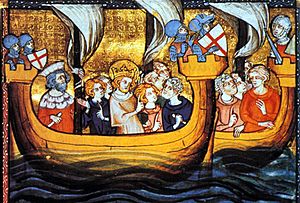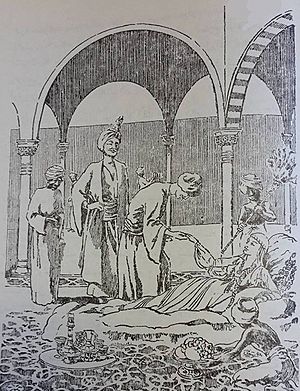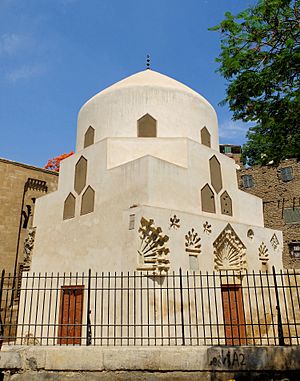Shajar al-Durr facts for kids
Quick facts for kids Shajar al-Durr |
|||||
|---|---|---|---|---|---|

Dinar coin of Shajar al-Durr
|
|||||
| Sultan of Egypt | |||||
| Reign | 2 May – 30 July 1250 | ||||
| Predecessor | Al-Muazzam Turanshah | ||||
| Successor | Izz al-Din Aybak | ||||
| Regent of Egypt | |||||
| Reign | 21 November 1249 – 27 February 1250 | ||||
| Born | unknown | ||||
| Died | 28 April 1257 Cairo |
||||
| Burial | Cairo | ||||
| Spouse |
|
||||
| Issue | Khalil | ||||
|
|||||
| Religion | Sunni Islam | ||||
Shajar al-Durr (meaning "Tree of Pearls" in Arabic) was a powerful ruler of Egypt. Her full royal name was al-Malika ʿAṣmat ad-Dīn ʾUmm-Khalīl Shajar ad-Durr. She was the wife of As-Salih Ayyub, who was a Sultan. Later, she married Izz al-Din Aybak, who became the first sultan of the Mamluk Bahri dynasty. Before marrying As-Salih Ayyub, she was a slave who later became his wife.
Shajar al-Durr played a very important role in Egyptian history. This was especially true after her first husband died during the Seventh Crusade against Egypt (1249–1250 AD). She became the sultana (female ruler) of Egypt on May 2, 1250. Her rule marked the end of the Ayyubid family's power and the beginning of the Mamluk era in Egypt. Historians believe she was of Armenian or Turkic origin. She was known for being beautiful, wise, and religious.
Contents
- Shajar al-Durr's Royal Title
- Early Life and Rise to Power
- Egypt Faces the Seventh Crusade
- Defeating the Crusaders
- Challenges with Turanshah
- Shajar al-Durr Becomes Queen
- Conflicts and the Mamluk State
- Shajar al-Durr's Death
- Architectural Legacy
- Shajar al-Durr's Impact on History
- Shajar al-Durr in Egyptian Stories
- Shajar al-Durr in Books and Movies
- Coins of Shajar al-Durr
- See also
- Images for kids
Shajar al-Durr's Royal Title
Many historical writings say that Shajar al-Durr used the title of "sultana." This is the female version of "sultan." However, on the only coin found from her time, she is simply called "sultan." This shows her strong claim to power.
Early Life and Rise to Power
Shajar al-Durr was bought as a slave by As-Salih Ayyub before he became Sultan. She traveled with him and a Mamluk named Rukn al-Din Baybars to Al Karak in 1239. This was when As-Salih Ayyub was held there.
When As-Salih Ayyub became Sultan in 1240, she moved with him to Egypt. She gave birth to their son, Khalil. After Khalil was born, As-Salih Ayyub married her.
Egypt Faces the Seventh Crusade
In April 1249, Sultan As-Salih Ayyub was very sick in Syria. He returned to Egypt because he heard that King Louis IX of France was planning an attack. Louis IX had gathered a large army in Cyprus to invade Egypt.
In June 1249, the crusaders landed in Damietta, a town at the mouth of the Nile River. As-Salih Ayyub was moved to Al Mansurah, a safer town. He died there on November 22, 1249. He had ruled Egypt for almost 10 years.
Hiding the Sultan's Death
Shajar al-Durr and two important officials decided to keep the Sultan's death a secret. This was because Egypt was under attack by the crusaders. They secretly moved his body to a castle on al-Rudah island.
They also sent for the Sultan's son, Al-Muazzam Turanshah, who was in Hasankeyf. To keep the secret, they forged documents in the Sultan's handwriting. They made people believe the Sultan was just sick, not dead. Shajar al-Durr even had food prepared for him every day. High officials and soldiers were made to promise loyalty to the "sick" Sultan, his son Turanshah, and the army commander Fakhr ad-Din Yussuf.
Defeating the Crusaders
The crusaders in Damietta soon heard about As-Salih Ayyub's death. With more soldiers arriving, they decided to march towards Cairo. A crusader group attacked the Egyptian camp near Al Mansurah. The Egyptian army commander, Fakhr ad-Din, was killed.
Shajar al-Durr agreed to a plan by Baibars to defend Al Mansurah. The crusaders were trapped inside the town. The Egyptian army and townspeople, led by future Mamluk leaders like Baibars and Aybak, defeated the crusader force.
In February 1250, Sultan As-Salih Ayyub's son, Al-Muazzam Turanshah, arrived in Egypt. He was made Sultan. Shajar al-Durr then announced the death of As-Salih Ayyub. On April 6, 1250, the crusaders were completely defeated at the Battle of Fariskur. King Louis IX of France was captured.
Challenges with Turanshah
After the crusaders were defeated and King Louis IX was captured, problems started between Turanshah and Shajar al-Durr and the Mamluks. Turanshah wanted full control. He began replacing old officials with his own followers.
He also sent a message to Shajar al-Durr, demanding his father's wealth and jewels. This upset Shajar al-Durr. She complained to the Mamluks, who became very angry. On May 2, 1250, Turanshah was killed by Baibars and other Mamluk soldiers. He was the last Sultan from the Ayyubid family.
Shajar al-Durr Becomes Queen
After Turanshah's death, the Mamluks and other leaders decided that Shajar al-Durr should be the new ruler. They chose Izz al-Din Aybak to be the commander-in-chief. Shajar al-Durr agreed to rule.
She took the royal name "al-Malikah Ismat ad-Din Umm-Khalil Shajar al-Durr." She also used titles like "Queen of the Muslims" and "Mother of al-Malik al-Mansur Khalil." Her name was mentioned in prayers in mosques, and coins were made with her titles. She signed official papers using the name "Walidat Khalil" (Mother of Khalil). By using her late husband's and dead son's names, she hoped to gain respect and show her right to rule.
After she became queen, King Louis IX, who was still a prisoner, was allowed to leave Egypt. He paid a large ransom and gave up Damietta. He then sailed to Acre on May 8, 1250.
Conflicts and the Mamluk State
News of Turanshah's murder and Shajar al-Durr becoming queen reached Syria. Syrian leaders refused to accept her as ruler. The Abbasid Caliph in Baghdad also did not recognize her. This was a big problem because, at that time, a ruler needed the Caliph's approval to be seen as legitimate.
Because of this, the Mamluks decided to make Izz al-Din Aybak the new Sultan. Shajar al-Durr married him and gave up her throne to him after ruling for about three months. Even though her rule was short, it was very important. It saw the end of the crusaders' attempts to conquer Egypt and the beginning of the Mamluk state. This new state would become very powerful in the Middle East for many years.
To please the Caliph, Aybak said he was just representing the Caliph. To calm the Syrian Ayyubids, the Mamluks named a young Ayyubid boy, al-Sharaf Musa, as a co-sultan. But this did not stop fighting between the Mamluks and the Ayyubids. Eventually, they made a peace agreement. The Mamluks gained control over southern Palestine and the Syrian coast. This agreement helped their new state gain recognition.
Aybak also faced rebellions within Egypt. He became worried about the growing power of some Mamluks who had helped him become Sultan. So, he had their leader, Faris ad-Din Aktai, killed. Many Mamluks, including Baibars, then fled to Syria. Aybak became the sole ruler of Egypt.
Shajar al-Durr's Death
By 1257, Aybak and Shajar al-Durr had many disagreements. Aybak wanted to be the supreme ruler, and Shajar al-Durr, who had once been queen, was very strong-willed. She kept royal matters secret from Aybak and wanted him to divorce his other wife.
Aybak decided to marry the daughter of a powerful leader from Mosul. This leader warned Aybak that Shajar al-Durr was in contact with his enemies. Feeling threatened and betrayed, Shajar al-Durr had Aybak killed by servants in 1257. He had ruled Egypt for seven years.
Shajar al-Durr claimed Aybak died suddenly. But his Mamluk followers did not believe her. The servants involved confessed under torture. Shajar al-Durr and the servants were arrested. Aybak's Mamluks wanted to kill her. She was protected by other Mamluks and taken to a tower.
Aybak's 15-year-old son, al-Mansur Ali, was made the new Sultan. On April 28, Shajar al-Durr was killed by the servants of al-Mansur Ali and his mother. The servants who killed Aybak were also executed.
Shajar al-Durr was buried in a beautiful tomb near the Mosque of Ibn Tulun in Cairo. Her tomb is known for its stunning Islamic architecture. Inside, there is a prayer niche decorated with a mosaic of a "tree of life." This design likely refers to her name, "Tree of Pearls."
Architectural Legacy
Shajar al-Durr was known for her unique approach to architecture. She combined the style of Mamluk tombs with Madrasas (Islamic schools). She was the first Islamic Sultan of Egypt to use this blend of styles. Her burial structures influenced future Mamluk leaders. This showed that Islamic schools were important and continued to be used by the Mamluks.
In 1250, Shajar al-Durr added a tomb to her husband's school, the Salihiyya. This made schools and other charitable buildings also serve as monuments to remember people. This practice became very popular among Mamluk rulers.
She also built a mausoleum for herself between 1250 and 1257. Only the tomb remains today, and it has been restored. This tomb was also a very special and new type of building. It had an image of an upright branch with pearlescent fruit in its prayer niche. This image clearly referred to her name: shajar (tree) and durr (pearls).
Shajar al-Durr's Impact on History
Shajar al-Durr was a former slave who was not from the Ayyubid royal family. She holds the special place of being the first Mamluk ruler of Egypt and Syria. Before their deaths, Aybak and Shajar al-Durr firmly established the Mamluk dynasty.
This Mamluk dynasty later pushed back the Mongols. They also drove the European Crusaders out of the Holy Land. The Mamluks remained the most powerful political force in the Middle East until the Ottomans arrived.
Shajar al-Durr in Egyptian Stories
Shajar al-Durr is a character in "Sirat al-Zahir Baibars," a long folk epic from Egypt. This story mixes facts with fiction and shows how much ordinary Egyptians admired both Baibars and Shajar al-Durr.
In the tale, she is called Fatma Shajarat al-Durr. She is the daughter of a Caliph whose kingdom was attacked by the Mongols. She was called "Tree of Pearls" because her father dressed her in a pearl gown. The story says her father gave her Egypt, and As-Salih Ayyub married her to stay in power.
When Baibars came to Cairo, she loved him like a son. The story also says a bad man named Aybak al-Turkumani tried to steal Egypt. Shajarat al-Durr killed Aybak with a sword. But while running from his son, she fell from the citadel roof and died. In poetry, her name is often shown as a fruit tree made of mother-of-pearl.
Shajar al-Durr in Books and Movies
Shajar al-Durr is mentioned in Tayeb Salih's story "The Wedding of Zein." A character in the story says, "A man's a man even though he's drooling, while a woman's a woman even if she's as beautiful as Shajar ad-Durr."
In 1935, a film about her called Shajarat al-Durr was made by Ahmad Galal.
Coins of Shajar al-Durr
Coins from Shajar al-Durr's rule had these names and titles on them: "al-Musta'simiyah al-Salihiyah Malikat al-Muslimin walidat al-Malik al-Mansur Khalil Amir al-Mu'minin." This means "The Musta'simiyah the Salihiyah Queen of the Muslims Mother of King al-Mansur Khalil Emir of the faithful." Her name, Shajarat al-Durr, was also on them. The name of the Abbasid Caliph, Abd Allah ben al-Mustansir Billah, was also inscribed on her coins.
See also
 In Spanish: Shajar Al-Durr para niños
In Spanish: Shajar Al-Durr para niños
Images for kids








